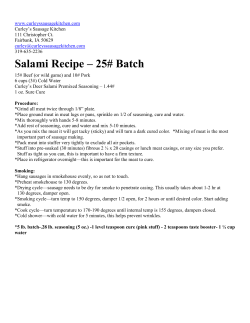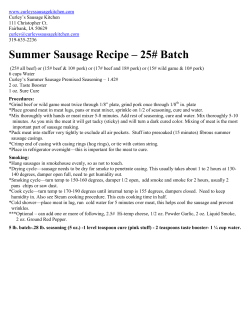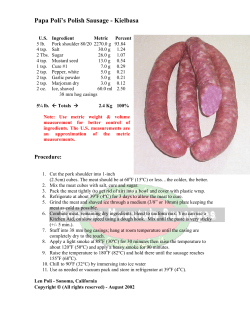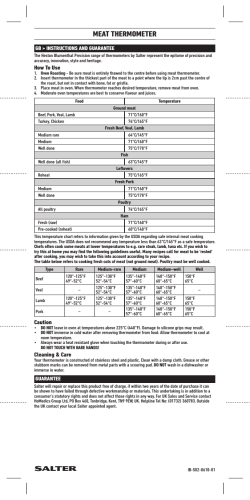
I BUILD AN OLD-FASHIONED SMOKEHOUSE
March/April 1999 Backwoods Home Magazine SELF-RELIANCE BUILD AN OLD-FASHIONED SMOKEHOUSE Plywood & shingles Plywood siding Screen covered with metal lath Sturdy pipes for delicious meat and better storage BY REV. J.D. HOOKER I ’m not at all surprised at the large numbers of smoke cookers that I’ve been noticing among so many rural folks, and among many urbanites as well. Just about any sort of meat, fish, or fowl prepared using this sort of cooking method ends up tasting truly delicious. Still, about all that you can get from these smoke cookers, or hot smokers, is flavor, as the keeping qualities of foods prepared in this manner is not enhanced at all. The only method that I know of which can lengthen the keeping qualities of such meats, while allowing you to enjoy this same unique taste, involves building a standard old-style smokehouse, and using cold-smoking methods. Sure, many commercial meat processors still employ this style of smokehouse, yet theirs are usually huge, commercial set-ups. For the use of a single family, a simple fourfoot by eight-foot shed of approximately seven feet in height will handle all of the meat preserving needs you could encounter. Such a simple smokehouse can provide you with 220 cubic feet of smoke-filled area, and it is still easily put together using standard sizes of plywood and lumber. Once you’ve selected a site to erect your smokehouse (the top of a slope is ideal), begin by making corner cutouts in your sheet of ¾-inch plywood. As an aid in marking out where to dig the holes for setting the building’s corner posts, lay this plywood flat on the ground. You’ll then need to use a post hole digger to sink holes deeper than your local frost line (three feet in our area). Next, you’ll need to use a level to keep each corner post plumb as you tamp the dirt solidly back in place around them. Then measure down exactly 8 feet from the top of the tallest posts, and again use your level to keep everything “true” as you install the floor joists and ¾-inch plywood flooring, as shown. 12 Metal flashing Old coffee can with holes Treated posts placed 3-feet deep Converted 55-gallon drum MATERIALS LIST: To erect your own smokehouse in these dimensions, you can either design your own, or go by the following materials list and guidelines: 2 pressure-treated 4"x4"x14' (cedar, locust, or other rot-resistant wood can be substituted). 2 pressure-treated 4" x4"x 12' 5 2"x4"x10' lumber 18 - 2"x4"x8' lumber 3 - 2"x4"x12' lumber 7 - 4'x8' sheets of 3/8" plywood or OSB board 1 - 4'x8' sheet of 3/4" plywood or OSB board 1 roll of metal roof flashing 1 square worth of roofing material 18 4-foot long pieces of 3/4" iron gas pipe or other sturdy pipe 2 - T or strap type hinges 20 feet of 1"x 2" lumber several yards of heavy gauge wire 10 or 12 feet of 24-inch wide window screen 10 or 12 feet of 24-inch wide expanded metal lathe 12d and 7d nails, and roofing nails March/April 1999 Backwoods Home Magazine Now, nail the wall studs and roof rafters in place, then cover the exterior of the walls and roof with the 3/8-inch plywood, making certain to provide a doorway. You can build it like the one illlustrated, or use your own variations. As shown in the illustration, use the 1"x2" lumber to fashion braces for the section of plywood removed for the doorway. Use the hinges to hang this in place as a door. A lock and hasp, a simple barrel bolt, a large hook and eye, or anything similar can be used to keep the door shut. Install whatever sort of roofing material you prefer. For our family’s use, I found the painted canvas type roof which I’ve written about in issue #39 of BHM ideal for this purpose. To prevent rodents and other animal pests from climbing up and gnawing their way into your smokehouse, you’ll need to cover the exposed portions of your four corner posts from the ground to the floor joists with metal flashing. The smooth surface of the flashing prevents rats, cats, and other creatures from getting any sort of a hold to climb up. At this point, you’ll want to brush on a couple of coats of non-toxic exterior paint, both inside and outside of your smokehouse. For the interior I picked a glossy white latex exterior paint. It makes scrubbing down the smokehouse interior after each use just a little easier. Instead of using wood to fill in the spaces between the rafters, use fine window screen and metal lathe to cover each of these spaces. This will allow the smoke to slowly escape, which prevents imparting a stale, flat taste to your foods. As shown, notch 12 pieces of 2"x4" and nail them in place along the long sides of the shed. These will support the lengths of pipe from which you will hang your food. When larger pieces of meat are to be smoked, extra support is added with heavy gauge wire suspended from the rafters. All that remains to be done before putting your new smokehouse into use is to provide a means of keeping the building filled with smoke. One good method for doing so is shown in the illustration. The only things you need for this method are a 55-gallon metal drum, some 6-inch stove pipe, one short section of 6-inch triple wall pipe to go through the floor, and an old three-pound or larger coffee can. When you’re ready to use this stove to provide smoke for the food in your smokehouse, you’ll need to build up a hot fire of hardwood, such as hickory, oak, or ash, and allow this fire to burn down until the bottom of the barrel is filled with hot glowing coals. Once the coals are ready, shovel dampened hardwood sawdust, ground corn cobs, shredded hickory bark, or something similar over them. Keep shoveling in more of this damp (not wet) material every hour or two, as needed. It wouldn’t hurt to add a small outdoor thermometer inside the door of your smokehouse, because once the original large fire has burned down, you’ll never want the inside temperature to exceed 100 degrees F. While you do need to stick with hardwoods for smoking foods, to avoid a nasty taste I recommend doing some experimenting on your own with different species of sawdust, wood chips, ground-up corn cobs, and such to determine the flavors you personally prefer. My family especially likes hickory or corn cobs for hams and bacon, a mixture of apple wood and corn cobs for beef and venison, sugar maple for waterfowl, and a mixture of hickory and beech for chicken, turkey, and upland birds such as pheasant. You may wish to give these a try for starters, adjusting the wood species to meet your own tastes. Some meats, such as thinner cuts of lean beef and venison, will not only have their flavors greatly enhanced, but their storage lives extended remarkably by smoking. Many other foods, especially fatty meats like pork, most fish, and many sorts of fowl, require some type of curing (usually employing salt, sugar, syrup, or some combination of these) before the meat is smoked, or its keeping qualities won’t be much improved, if at all. Before giving you a few of the curing methods that we’ve found especially to our liking, I probably should mention that all meats seem to spoil quickest close to the bone. For this reason, I’ve always boned out all of the larger pieces of meat intended for our smokehouse, and employed only dry type cures on these larger pieces, packing the “hollows” where the bones used to be with the cure mixture. The following are some of the curing methods which our family routinely uses: Dry cures For Fish: Clean each fish and wash thoroughly in clear water. Make a brine mixture using 1 cup of salt per gallon of water. Soak the fish in this brine for 30 minutes to draw out any blood remaining in the fish. Then rinse very well in cold fresh water and set aside to drain. Spread a thin layer of pickling salt in the bottom of a large plastic, glass or stainless steel container. Add a single layer of fish and another thin layer of salt. Continue alternating layers of fish and salt, until the container is filled, or all of the fish has been used up. Refrigerate the container with the salted fish for 48 hours. Rinse the fish thoroughly and scrub away any particles of salt, then hang the pieces of fish in a cool, shady spot for about four hours, until the surface is covered with a shiny “skin.” Use pieces of stiff wire, bent into an “S,” to hang all of the fish on the pipes inside your smokehouse. Keep the smokehouse filled with very dense 13 March/April 1999 Backwoods Home Magazine smoke and leave the fish inside for a full five days. Remove the fish and wrap each one separately, then store in a cool, dry place. For waterfowl: Soak the bird overnight in a seasoned brine, made by adding 3 cups pickling salt, 1 cup of brown sugar, 1 tablespoon black pepper, and 6 or 7 whole cloves per gallon of water. Then rinse well and pat dry. Rub pickling salt very heavily inside the body cavity. Place the bird on top of a thin layer of pickling salt inside a plastic, glass, or stainless steel container. Coat the outside of the bird as heavily as possible with pickling salt and refrigerate for 48 hours. Rinse very well with cold, fresh water, then pat dry. Hang in a cool place, out of direct sunlight, for 5 hours. Then hang the bird inside the smokehouse, which is then kept full of very dense smoke for 7 days. For hams, shoulders and bacon: For each hundred pounds of meat, mix together 2 pounds of dark brown sugar, 8 pounds of pickling salt, 2 ounces each of black and red pepper, 2 ounces of saltpeter (optional), and 1 ounce of crushed cloves. Dampen the meat well with fresh water and rub this mixture well into all sides of the meat. Place a layer of pickling salt in the bottom of a wooden or plastic barrel, then place pieces of meat on top of this layer of salt. Cover this meat with a thin layer of salt. Continue alternating layers of salt and meat until the container is full or the meat is gone. Make certain to finish with a layer of salt on top. Every six or seven days, the barrel should be unpacked, the pieces of meat rubbed again with the salt/sugar spice mixture, and then repacked using the same salt. Using the largest piece of meat as a guide, leave the meat packed in the pickling salt for three days per pound. At the end of the curing time, wash the meat thoroughly and hang it to dry inside the smokehouse (without using any fire or smoke) for 24 hours. Then build up the fire, and keep the smokehouse filled with dense smoke for 12 14 days. After smoking, wrap the meat in a double layer of cheesecloth, then in brown butcher’s paper, and hang in a cool dark place to “age” for at least 3 months before using. For beef, venison, and other red meats: Entire shoulders, whole rib or round cuts, or whole briskets, can be boned for this sort of use. Refrigerate the meat for at least 24 hours before starting to cure. Use approximately 5 pounds of pickling salt and 2 ounces of saltpeter (optional, but without the saltpeter, your meat won’t retain a fresh reddish color), per 100 pounds of meat. Place a thin layer of this mixture in the bottom of a wooden or plastic barrel, then add a layer of meat. Cover the meat with this mixture, then sprinkle on black pepper and garlic powder liberally. Add another layer of meat, treating it in the same manner. Keep alternating layers until the barrel is full, or all of the meat has been used up. After 24 hours, weigh the meat down with a wooden lid with a couple of scrubbed, heavy rocks on top. After 60 days, remove the meat and dry each piece separately. Rub each piece heavily with a mixture of 6 parts black pepper, 5 parts coriander, 3 parts allspice, 1 part white or red pepper, and 1 part garlic powder. Refrigerate overnight. Hang the meat inside of the “unlit” smokehouse to dry—and “set up” a little—for 24 hours before smoking. Then keep the smokehouse filled with very dense smoke for 12 days. Wrap with a double layer of cheesecloth, then a layer of butcher’s paper, and hang to “age” for a couple of months before using. Once aged, roasted, and thinly sliced, venison cured and smoked in this manner tastes remarkably like deli-store pastrami. Many other foods aside from meats can have their flavors enhanced by leaving them inside of your smokehouse for a few days. Most cheeses, especially cheddar, can be placed inside of bags made up of cheesecloth and hung inside the smokehouse for from 2 to 4 days. For a real taste treat, pecans, almonds, cashews, hickory nuts, and many other nuts can be roasted in vegetable oil, then hung in the smokehouse to absorb the extra flavor for a day or two. Possibly the best-tasting homemade chili powder that I’ve ever encountered was prepared from dried red peppers which had hung in the smokehouse for about 3 days before being ground into a flour-fine powder. If you’re interested in preserving some of your own meats, fish, game, fowl, and other foods at home, while allowing yourself a real taste treat, then building and using your own family-sized smokehouse is exactly what you’re looking for. Good eating. ∆
© Copyright 2026











